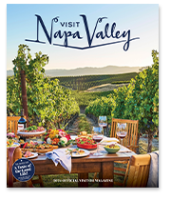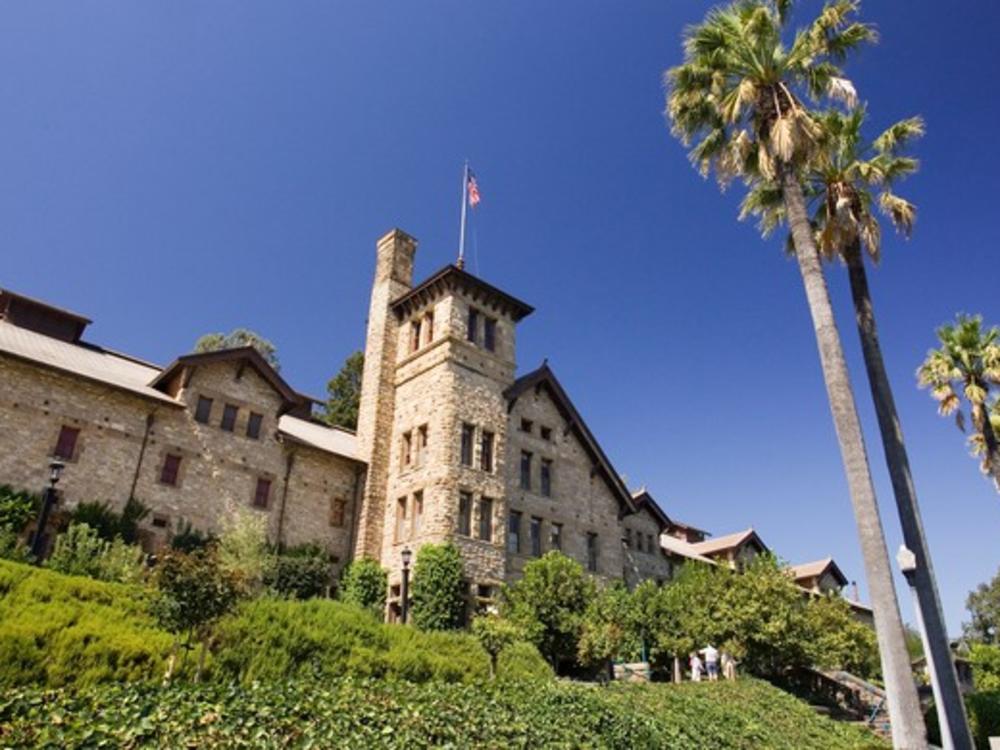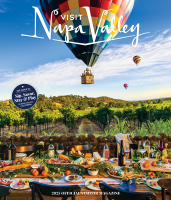The natural beauty of the Napa Valley has inspired many of the worlds most influential architects who have helped shape the design landscape of the Valley. Below is an overview of the architects who have influenced the Napa Valley over the last century.
Howard Backen (1936 - )
Howard Backen is considered by many to be the creator of the “Napa Valley style,” never flashy, always easy on the land and pleasing to the eye. Stone, timber and concrete enhance the landscape and become one with the surroundings, always sustainable, always environmentally prudent. In his words, you do not start with a style, "a style will emerge following the consideration of other factors, including use, site, purpose, practicality and setting[1]." Examples of Backen’s work include:
Dana Estates – St. Helena, CA
Located on Napa Valley’s western slope, Backen, Gillam & Kroeger designed the renovation of what was the stone ruins of a winery dating back more than 100 years. In addition to creating a hospitality space, the winery’s unique cave system incorporates all other aspects of a winery.
Edge Hill Estate – St. Helena
Backen, Gillam & Kroeger designed the new entrance and renovation of the existing masonry ruins on the site of the historic Distillery No. 209. The renovation included a fermentation and hospitality space.
Harlan Estate – St. Helena, CA
This facility is integrated with a private residence. It has a wood framed fermentation building over a partially buried concrete barrel cellar. The barrel cellar is temperature controlled by a radiant system in the floor and walls.
Larkmead – St. Helena, CA
Designed in the style of traditional Napa Valley agricultural buildings, construction consists of prefabricated metal structures skinned in wood board-and-batten siding, with a stone base and corrugated metal roof.
Napa Valley Reserve – St. Helena
Backen, Gillam & Kroeger designed this private vineyard and winery that spans 80 acres in the heart of the Napa Valley near Meadowood Resort. The Reserve encompasses a winery, aging caves, kitchen facility and gardens.
Ovid Napa Valley – St. Helena, CA
The winery is classically proportioned and built of timeless materials, including wood, stone and concrete, interleaved with modern windows, hatches and skylights, and powered by solar energy. This private winery has a simple horseshoe cave system with both 14 and 26 foot wide caves. The caves contain both one-barrel high fermentation space as well as the hospitality room. The winery is gravity fed with fermentation tanks comprised of stainless steel, concrete and oak barrels.
Cliff Lede – Yountville, CA
This vineyard consists of four buildings spread between three properties. It has a steel frame cave portal building for fermentation, as well as cave fermentation and an extensive grid of 14 foot wide caves for barrel aging. Fermentation is gravity fed by a crane system.
Bond Estates – Napa, CA
The construction of this family winery consists of a radial cave with spoke connector caves and a cut and cover fermentation cave portal with a radiant floor system. The concrete cave portal has a Nevada sandstone veneer, the hospitality space above is made with reclaimed wood.
Tamber Bey – Calistoga, CA
The winery is located at the Sundance Ranch in Calistoga, a world-class, 22-acre equestrian facility that is dedicated to training top performance horses. The winery was built in 2013 by remodeling a 15,000-square-foot covered riding arena into a state-of-the-art winemaking facility with a crush pad that houses 36 fermentation tanks sized for individual vineyard-designated wines.
Other Backen projects include Meadowood Napa Valley and Spa, Davis Estate, Futo Estate, Witt Estate and Continuum.
BAR Architects
One of only a few architecture firms certified as a San Francisco Bay Area Green Business, BAR Architects is fortunate to be able to commit to the Public Architecture one percent pro-bono program that connects non-profit organizations with design firms willing to donate their time.
Assisting in neighborhood revitalization and participating in the US Green Building Council (USGBC) and the American Institute of Architects (AIA) Committee on the Environment (COTE), as well as pro-bono endeavors, provide an understanding of the BAR definition of community. Examples of their work include:
Silverado Vineyards – Napa, CA
Inspired by Bernard Maybeck and Julia Morgan, Silverado Vineyards reflects the architectural heritage of the California Craftsman style. With its low-pitched roof, wide eaves and decorative braces, Silverado Vineyards is rich in detail. Visitors approach the winery up a winding road and are welcomed at the stone terrace entry and vibrant facade. Located to the west of the existing winery, the expansion includes a new visitor's center with a spacious wine tasting room with views of the Napa Valley.
Starmont Winery – Napa, CA
Designed to reflect the client’s desire for simple, rural building forms that blend into the agrarian landscape, the massing and materials were chosen to form a fitting gateway for visitors arriving to Napa Valley, the heart of California’s wine industry.
The facility incorporates many aspects of sustainable design practices. The extensive use of steel as both structure and exterior finish allows 85 percent of materials to come from recycled sources. Exterior landscaping utilizes low water usage plants and incorporates bioswales for collection and natural filtering of rainwater. The most visible aspect of sustainable design are the photovoltaic panels which cover approximately 90 percent of the south-facing roof surfaces.
Mumm Napa– Napa, CA
Located on the scenic Silverado Trail in the Napa Valley on a 73.7-acre site, this 210,000-case capacity sparkling wine facility contains a 9,600 square foot tour and tasting complex as well as retail facilities and art gallery. The winery buildings are set into the base of an existing knoll that takes advantage of the ambient temperature of the earth for natural cooling and insulation, and reduces the visual impact of the buildings from the Silverado Trail. A daylight-filled wine tasting room with picturesque views of the vineyards provides an inviting place to leisurely enjoy a flavorful glass of wine.
Staglin Family Vineyards – Rutherford, CA
Built into a steep hillside so none of the vineyard land and aging oak trees would be displaced, the Staglin Family Winery and Caves naturally provides ideal temperature and humidity for optimum production and storage for premium wines including Cabernet Sauvignon, Chardonnay and Sangiovese. The 25,000 square foot underground winemaking facility utilizes state-of-the-art tank technology. Custom constructed sorting tables, destemming equipment and conveyor belts provide gentle handling of the grape, preventing any compromise in quality.
Robert Mondavi Winery “To-Kalon Project” – Oakville, CA
The “To-Kolon Project,” named after the winery’s signature vineyard in Oakville, included a re-routing of the tour of the winery through the vineyard, the cellar and the tasting and retail rooms. The project also included an underground chais for the aging of Robert Mondavi Cabernet Sauvignon Reserve in new French Oak barrels. A new fermentation cellar was also constructed and outfitted with more than fifty new Taransaud upright French Oak fermenters. The movement of wine in the cellar is done completely by gravity, the most gentle of all methods.
Cardinale Winery – Oakville, CA
The expansion of an existing 1970's stone building includes a new second story addition which provides visitors with dramatic views of the valley and glimpses into the fermentation tanks located a floor below.
Hamden McIntyre (1834 – 1909)
Hamden McIntyre was a proponent of the concept of "gravity flow." His multiple story wineries accomplish this task and his propensity for huge, stately, chateau-like structures, mostly of stone construction, helped change the appearance of Napa Valley from a typical Northern California agricultural zone to an oasis of European culture[i]. Examples of McIntyre’s work include:
Far Niente – Oakville, CA
Far Niente was established in 1885 by John Benson, a forty-niner of the California gold rush and uncle of the famous American impressionist painter, Winslow Homer. Benson hired architect Hamden McIntyre, creator of the former Christian Brothers winery, now the Culinary Institute of America at Greystone, to design the building. Constructed against a hillside in western Oakville, Far Niente functioned as a gravity flow winery, gently moving the grapes through each stage of production. Abandoned in 1919 after Prohibition, the winery was restored in 1979 by Gil Nickel.
Inglenook – Rutherford, CA
Gustave Niebaum, a Finnish sea captain, wine connoisseur and entrepreneur, founded Inglenook in 1879. Niebaum commissioned William Mooser, a San Francisco architect, to design the great chateau in conjunction with Hamden McIntyre, who provided the design for the winery. Construction on the present winery began in 1881.
Trefethen – Napa, CA
Constructed in 1886 by McIntyre, the winery was originally known as Eshcol. The Trefethens purchased the property in 1968 and restored it, only replacing the dirt floor with concrete. It was placed on the National Register of Historic Places in 1988. After being severely damaged in the August 2014 Napa earthquake, the Trefethens have undergone a complete restoration of the property.
Other McIntyre designed wineries include: Chateau Montelena, Beaulieu Vineyards, Christian Brothers' Greystone (now Culinary Institute of American at Greystone), and Whetstone.
Signum Architects
Juancarlos Fernandez & Jarrod Denton
Partners Jarrod Denton and Juancarlos Fernandez met early in their careers while working together at a Napa Valley architecture firm. Due to similarities in values and work ethic, they combined their talents to found Signum Architecture in early 2011. Their mission is to engage the power of architecture to stir emotion and invoke reflection while setting the stage for inspired living. Examples of their work include:
Cade Winery– Angwin, CA
The design honors the owner’s dedication to environmentally sustainable winemaking. An inverted roof, floating over a row of clerestory windows, visually disappears - leaving a striking complex of concrete walls. Strong vertical elements of wood throughout, evoke the dark, towering, fir trees in the background.
HALL Winery – St. Helena, CA
On the valley floor, this building sits between two mountains, drawing tasters from all sides. Upon entry, guests are drawn into a quieter, darker space, close to the winemaking process, and then released back out toward the openness of the valley. The buildings' natural materials: weathering steel, warm concrete, and stone, unite it with the adjacent, historic building. The curtain of transparent, low iron structural glazing is stunning and dynamic. The glass reveals the warm interior materials and reflects the splendor of the landscape.
Odette Estate – Napa, CA
This winery was created to produce elegant and feminine wines, which they sought to reflect in the architecture. The side view of the facility evokes the sweeping curve of a swan’s wing, inspired by the Tchaikovsky ballet character Odette. The unique production building adds an organic element to the light and modern hospitality facilities already on the property. The round footprint responds to its location, tucked into a natural cove made by hillsides on three sides. The living roof appears to have been pushed up from the earth to reveal the veil-like screen of perforated aluminum that shelters the work pad at the front of the facility. Inside the screen, a line of tall, dark panels in voluptuous shapes may be slid across the space, creating a whimsical entry that is screened from office and winery activities beyond.
William Turnbull (1935 – 1997)
Born to architect parents, and the great-grandson of George B. Post, who designed the New York Stock Exchange building, Turnbull studied at Princeton and was influenced by the sea through his work at Big Sur, later creating the iconic Sea Ranch community. His style uses simple shed-like structures of wood and natural light that combine to appear like abstract sculpture. While he produced buildings all over the country, as the years went on he increasingly defined himself as a Bay Area architect, concerned with finding a means to enhance a sense of connection to the northern California region[ii]. Examples of Turnbull’s work include:
Turnbull Wine Cellars – St. Helena, CA
William Turnbull founded Johnson Turnbull Vineyards in 1979. He designed Turnbull Cellars to be low key and in tune with its environment. It’s a classic example of a small hands-on Napa Valley operation. William Turnbull once said, “You want to have an image of a winery that cares about the last drop of wine in the bottle.”
Long Meadow Ranch – St. Helena, CA
A departure from Turnbull's typical style, the Long Meadow Ranch Winery is a wine and olive oil-making structure on a ranch below the Mayacamus Mountains. Sited on a gently sloping hill backed by forests, the building digs into the hill on the north side to take full advantage of the passive cooling opportunities. Caves for wine storage run deep into the hillside. The tailings of the caves were used to create the pisè walls that enclose the building.
Cakebread Cellars – Rutherford, CA
The initial winery for Cakebread Cellars was built in 1974, and a new winery building, designed by Turnbull, was added in 1980. His vernacular design, which blends with the vines and surrounding valleys, won awards from the California Architects Association in 1981, the East Bay Architects Association in 1982 and the AIA & Wood Council in 1983.
Single winery architecture projects:
Michael Graves (1934 – 2015)
Identified as one of The New York Five (Peter Eisenman, Michael Graves, Charles Gwathmey, John Hejduk and Richard Meier), Graves is known first for his post-modern building designs, often with great mass, Cubist interpretations of classical elements like colonnades and loggias.
Clos Pegase – Calistoga, CA
Clos Pegase began as a competition in May 1984 with the participation of 96 design teams. The esteemed competition jury, including the San Francisco Museum of Modern Art (SFMOMA), narrowed the field to five, and then declared the winning design to be that of architect Michael Graves. Construction of the Postmodern design was completed in 1987, merging modern and ancient Mediterranean Culture.
Graves describes the character of his creation as tending "to evoke memories of a European ancestry" and having a "timeless sensibility." The selection jury explained, "it embodies a celebration of the lifestyle that is unique to the Napa Valley."
Friedensreich Hundertwasser (1928 – 2000)
The common themes in his work utilized bright colors, organic forms, a reconciliation of humans with nature, and a strong individualism, rejecting straight lines. He was fascinated by spirals, and called straight lines "the devil's tools." He called his theory of art "transautomatism," based on Surrealist automatism, but focusing on the experience of the viewer, rather than the artist. This was encapsulated by his design of a new flag for New Zealand, which incorporated the image of the Koru, a spiral shape based on the image of a new unfurling silver fern frond and symbolizing new life, growth, strength and peace according to the Māori people.
Quixote Winery – Napa, CA
Smithsonian curator Harry Rand introduced Carl Doumani to the delightfully witty Viennese artist, architect, philosopher and environmentalist who would design Quixote. It was the magic of the Stags Leap Palisades and the little pond above the winery that captured Friedensreich’s soul. The winery was planned and built during the period 1988 to 1998. Hundertwasser had a lot of rules, all of which create the festive atmosphere that is Quixote: no straight lines; roofs are planted with grass and trees; every building is capped with a gold leaf onion dome to elevate man’s sense of himself; and color is king.
Herzog (1950 - ) & de Meuron (1950 - )
Their formal gestures have generally progressed from the purist simplicity of rectangular forms to more complex and dynamic geometries. The architects often cite Joseph Beuys as an enduring artistic inspiration and collaborate with different artists on each architectural project. Their success may be attributed to their skills in revealing unfamiliar or unknown relationships by utilizing innovative materials. From Basel, Switzerland, Jacques Herzog and Pierre de Meuron have constructed numerous renowned buildings, including the Tate Modern in London, the Allianz Stadium in Munich, the Prada boutique in Tokyo, the de Young museum in San Francisco and the "Bird's Nest" stadium in Beijing. In 2001, they were awarded the Pritzker Prize, contemporary architecture's highest award.
Dominus Estate – Yountville, CA
Completed in 1997, the Dominus Estate Winery is perfectly integrated into its landscape, offering panoramic views of the vineyard and hillsides. With its gabion facade, the winery seems to dissolve into its surroundings, an intentional effect, underscoring the importance of the vineyard in the production of a great wine. The winery was Herzog and de Meuron's first project outside of Europe.
Heiland Hoff Architecture, LLC
Howard Heid & Heiland Hoff
Vineyard 29 – St. Helena, CA
Completed in 2002, the 17,000 square foot winery is built of stone materials, and terraced with landscape plantings to fit beautifully within the natural landscape of the vineyards that surround it. The winery design is gravity flow in nature, increasing the quality of the wine produced and substantially reducing undesirable aeration by pumps and winemaking machinery. Designed to make the least environmental impact, the facility generates its own electricity using micro turbines. As a byproduct, this system “co-generates” all the winery’s hot and chilled water and cools the winery’s 13,000 square feet of caves.
Howard Heid & Heiland Hoff also completed the retrofit for Culinary Institute of America Greystone.
Johnson, Fain, & Pereira
Scott Johnson
Opus One – Oakville, CA
The building literally rises out of the earth, and through a mix of classical European and contemporary Californian elements, gradually discloses its distinctive beauty.
Defined by colonnades on either side, a central courtyard introduces an architectural motif found throughout the building. The winery, like the wine, joins New World and Old World aesthetics. Modern materials, including California redwood and stainless steel, are juxtaposed against cream-colored Texas limestone.
Beat Jordi (Bay–aht Yordee) - Deceased
Second generation architect Beat Jordi worked with Marcel Breuer before taking over Jordi + Partner AG in 1970. Now deceased, Jordi's son still runs the company in Switzerland. He designed the Museum of Natural History in Bern, the Swiss Embassy in Islamabad, the US Embassy in Bern, the Swiss Consulate & UN Mission in NY, and the Bundesplatz Branch of BEKB in Bern.
Hess Collection – Napa, CA
The original winery on Mount Veeder was hewn from native stone in 1903. Beat Jordi renovated the structure in the mid-1980's to house part of an art collection previously only shown in museums worldwide making the Hess Collection the premier showcase for Hess’s “two passions under one roof.”
Olle Lundberg
Hourglass Winery – Calistoga, CA
Olle Lundberg is a San Francisco architect who describes his style as “nature-inspired modernism.” Ownership requested he design a winery that celebrates modern Napa Valley rather than “borrowed architecture”, a design to embody their dedication the sense of place and their cutting-edge approach to winemaking. The winery is open for tasting to wine list members only.
Cliff May (1909 – 1989)
May, born in San Diego, was a West Coast-based architect best known for being the "father of the California ranch house." He designed residential projects around Southern California, Santa Barbara and the Monterey area.
Robert Mondavi Winery – Napa, CA
Robert Mondavi commissioned Cliff May to build his eponymous winery incorporating the features found in the construction of California Missions. He later commissioned May to design the residence Mondavi would live in for the duration of his life. Following Robert Mondavi's death in 2008, the residential property was auctioned at a price of $13.9 million, purchased by vintner Jean Charles Boisset and wife, Gina Gallo.
Domingo Darden Triay (DOB unknown -)
Artesa – Napa, CA
Artesa is a testament to the harmony between nature and architecture, a skillful example of interaction between structure and environment. Designed by renowned Barcelona architect Domingo Triay and built in the early 1990’s, the avant-garde structure was conceived to blend seamlessly with the surrounding landscape. Set into the highest hill of the 350-acre estate with a protective covering of native grasses, the winery is kept naturally cool by its earthen construction. On the interior, two stories below the main entrance, is the meticulously managed barrel room where small wine lots are fermented, aged and artfully blended.
UXUX (Amsterdam)
Merus – St. Helena, CA
One of Napa’s fabled “ghost wineries,” abandoned in the wake of Prohibition, was fully updated to include custom-made winemaking equipment and 7,000 square feet of caves for barrel storage. The winery’s tasting salon and a second tasting area in the caves were stunningly renovated by Merus co-founder Erika Gottl’s Amsterdam-based UXUS design consultancy. The winery is open for tasting by invitation only.








